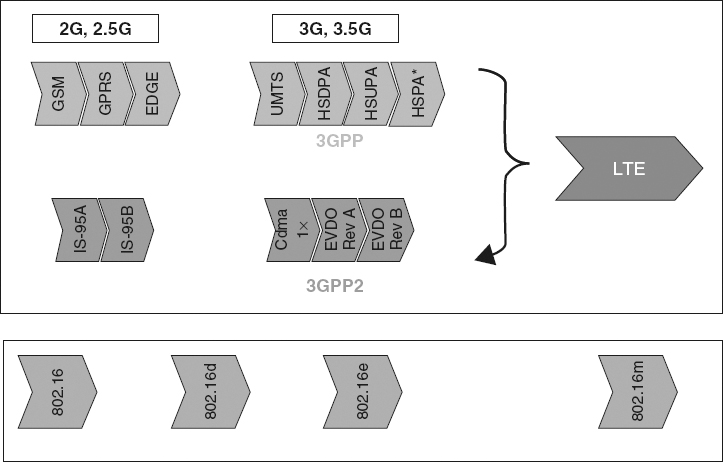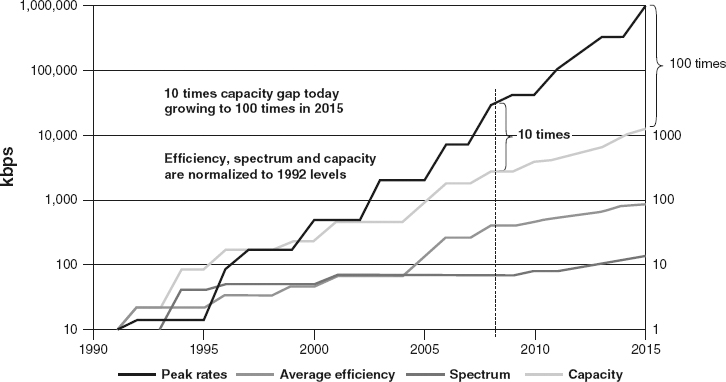Evolution of the IMT-Advanced Standards
Despite the many similarities between LTE and WiMAX, their origins are radically different. While LTE is the inheritor of a voice-service based technology, namely the voice circuit switching, WiMAX originated from a data-service based technology, the computer networks. In other words, WiMAX was born as an all IP technology while LTE went through a slow and long development stages to become an all IP network. The evaluation of both standards is shown in Figure 15.1.
LTE predecessors can be traced back to the circuit-switched analog, 1G networks. These networks were designed in the mid 80s to deliver voice services to mobile users. Shortly afterwards, the 2G circuit-switched networks had evolved to improve the quality of these services. This has been achieved through using digital communications techniques, including modulation and coding. In this generation, two technologies prevailed, the TDMA based GSM and the CDMA based IS-95. The development of these two technologies was led by two standardization bodies, 3GPP leading GSM and 3GPP2 leading IS-95. GSM supported voice services neatly; however, it fell behind in data services. This motivated the development of GPRS technology as a 2.5G network. This technology could successfully handle data services over the GSM circuit switched network. Since then, 3GPP continued its work in improving the performance of the data transmission capabilities by increasing the supported data rates over the GSM networks. This led to the introduction of EDGE in 2003, a technology that is capable of providing a theoretical data rate of 1 Mbps—three times the data rate of GSM networks.

Figure 15.1 LTE and WiMAX Evolution.
The next step in this development line was the introduction of HSPA, a 3G technology capable of delivering theoretical data rates up to 14 Mbps. The data rate was improved even further with the introduction of HSPA+ that increased the data rates over the two link directions; the uplink and the downlink. This technology is considered the big step towards LTE. It can be considered as a revolutionary development along the line, since it departed from the split circuit-packet switch network by introducing, for the first time, an all-IP architecture as an option for the voice and data services. In addition, HSPA+ integrated the MIMO technology as a major part of its PHY layer, paving the way for its integration in LTE.
A similar line of evolution was followed by the 3GPP2. It has progressively evolved IS-95 form a mere voice services network into the Evolution Data Optimized (EVDO) Rev B, a network that efficiently supports both data and voice services and at various mobility levels.
Meanwhile, the standard for WiMAX networks was produced by the IEEE in an attempt to extend the WiFi-like services into metropolitan and wide area networks, but at much higher data rates. Earlier work on the IEEE 802.16 standard was largely based on the Data Over Cable Service Interface Specification (DOCSIS), modifying the MAC layer to be more suitable to the wireless interface. In 2004, IEEE modified this version by introducing OFDM. This was the first version of the IEEE 802.16d standard. Hence, IEEE 802.16 originated from computer networks that are inherently efficient for data services. In fact, this is one of the differences between LTE and IEEE 802.16x. While LTE is a revolution of the voice services network, IEEE 802.16 is a revolution of the data services network.
The main motive for the development of the two standards was hence the need to offer higher and more reliable data rates to accommodates the increasing demand for mobile data traffic. Additionally, customers are expecting the service provider networks to support several types of applications including the bandwidth-hungry applications such as video streaming, video conferencing and gamming. Coping with the increased number of users and providing the continuous support for current and new developed bandwidth-hungry applications leave the broadband wireless communication designers restless finding different means to provide higher data rates. Figure 15.2 shows the gap between the available capacity of current technologies and the demand for data rate.
ITU produced a new set of requirements for future wireless networks. These requirements mainly focus on providing high data rates. In particular, it specifies a 1Gbps for fixed and slow mobility users and a 100Mbps for high mobility users. Neither IEEE 802.16-2009 nor LTE Rev.9 is capable of providing such rates. Hence, the two standardization groups, the 3GPP and the IEE needed to come with its own IMT-Advanced proposal. While the former proposed LTE-Advanced, the latter proposed IEEE 802.16m. As the names suggest, these two proposals are in fact enhancements of their ancestors, the LTE-Rev.9 and the IEEE 802.16-2009, respectively.

